- Matching (Score)
- Our verdict
- Competing TVs
- TV appearance
- Where to buy
- Contrast and black detail
- HDR effect quality
- Factory color reproduction
- Color reproduction after calibration
- Smoothness of tonal transitions
- Image scaling and smoothness of tonal transitions
- Blur and motion smoothness
- Console compatibility and gaming features
- Input lag
- Compatibility with PC
- Viewing angles
- TV efficiency during daytime
- TV features
- Apps
- Playing files from USB
- Sound
- Details about the matrix
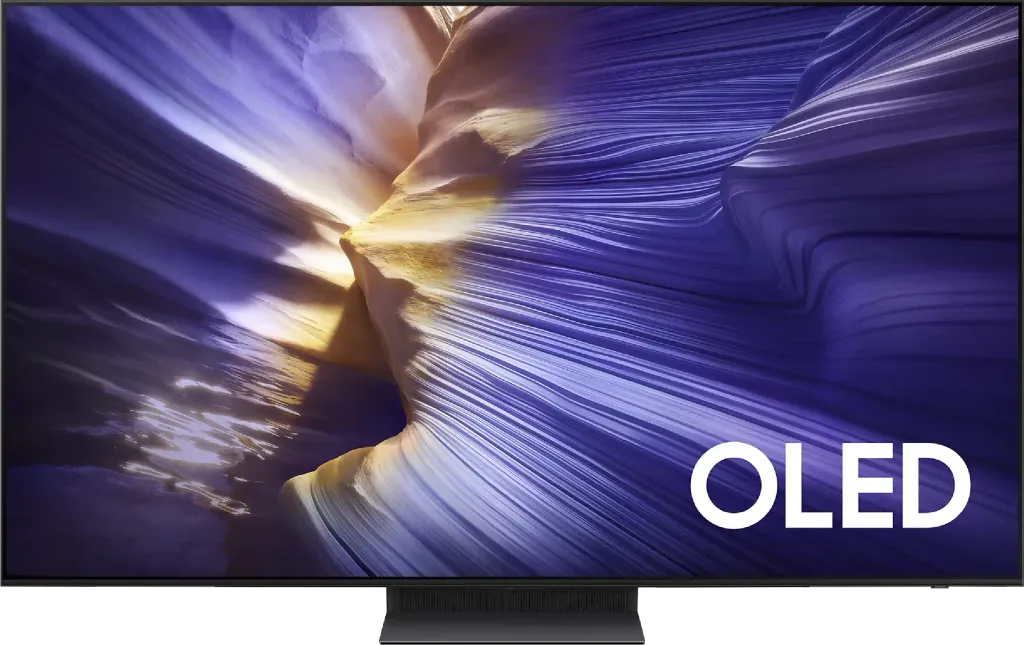
Complete the survey to find out the result
Panel type: WRGB OLED Odświeżanie: 144Hz Brand: SAMSUNG Resolution: 3840x2160 System: Tizen Model year: 2025
SAMSUNG OLED S90F - Our verdict
8.1
Overall rating
The Samsung S90F is an excellent representative of the premium mid-range in the world of OLED televisions. Here we have an organic matrix that guarantees perfect contrast – and no matter how hard LCD manufacturers try with local dimming in Mini LEDs, this black simply cannot be replicated. The S90F displays its class here without any compromises. Compared to last year's model, we get a slightly brighter WOLED panel that can achieve up to 1200 nits in favorable conditions. This is a result sufficient for comfortable viewing of HDR content in most scenes at reference quality – especially on streaming platforms like Netflix. The picture quality is at a very high level, regardless of whether we are watching a movie, playing on a console, or streaming a sports event. In fact – versatility is one of the greatest advantages of this model. With a 144 Hz refresh rate, very low input lag, and a full set of gaming features (including functioning HGiG and the unique Game Motion Plus motion smoother), it's hard to find anything to complain about. The Tizen system worked really well on the S90F. It has its limitations – primarily a closed ecosystem and fewer app options than Google TV – but if you mainly use the most popular services, this shouldn't be a problem. A big plus is also the remote control, which can operate most connected devices – even without a numeric keypad. There are also downsides. The built-in media player has issues with some formats, and the anti-reflective coating typical for WOLEDs doesn't cope very well with strong light – reflections can be noticeable. We also don't have support for DTS and Dolby Vision, but that's a standard at Samsung that has been to be expected for years. So is the S90F with a WOLED panel the perfect television? No – but it really is just a few things short. It's one of the most refined and complete OLEDs in this price range, capable of handling any content, from a series on Netflix to gaming on a console, to a Sunday match.
Advantages
Exceptional black and contrast
High brightness for an OLED TV - 1200 nits peak brightness
Very good motion fluidity - OLED panel 144Hz
Low latency - input lag 5ms
Gaming features: 4x HDMI 2.1, VRR, ALLM, Game Motion Plus, etc.
PiP function and excellent support for external devices with a solar remote
Advanced operating system: Tizen
Pleasant sound with a slightly noticeable bass
Disadvantages
Playback issues with some formats from USB.
Subtle degradation of tonal transitions (worse than the previous S90D)
No support for DTS:X – an external amplifier is required for full support of this format
Movies and series in UHD quality
8.3
Classic TV, YouTube
8.7
Sports broadcasts (TV and apps)
8.5
Gaming on console
9.6
TV as a computer monitor
8.6
Watching in bright light
6.1
Utility functions
7.5
Apps
8.2
Sound quality
7.4
Complete the survey to find out what fits your preferences
SAMSUNG OLED S90F - Competing TVs in this price range
SAMSUNG OLED S90F - TV appearance
HDMI inputs: 0 x HDMI 2.0, 4 x HDMI 2.1 (48Gbps) Other inputs: Toslink (Optical audio), IR (remote) Outputs: Toslink (Optical audio), eARC (HDMI), ARC (HDMI) Network Interfaces: Wi-Fi 2.4GHz, Wi-Fi 5GHz, Ethernet (LAN) 100Mbps
Build quality: Premium
Stand type: Central
Kolor ramki: Graphite
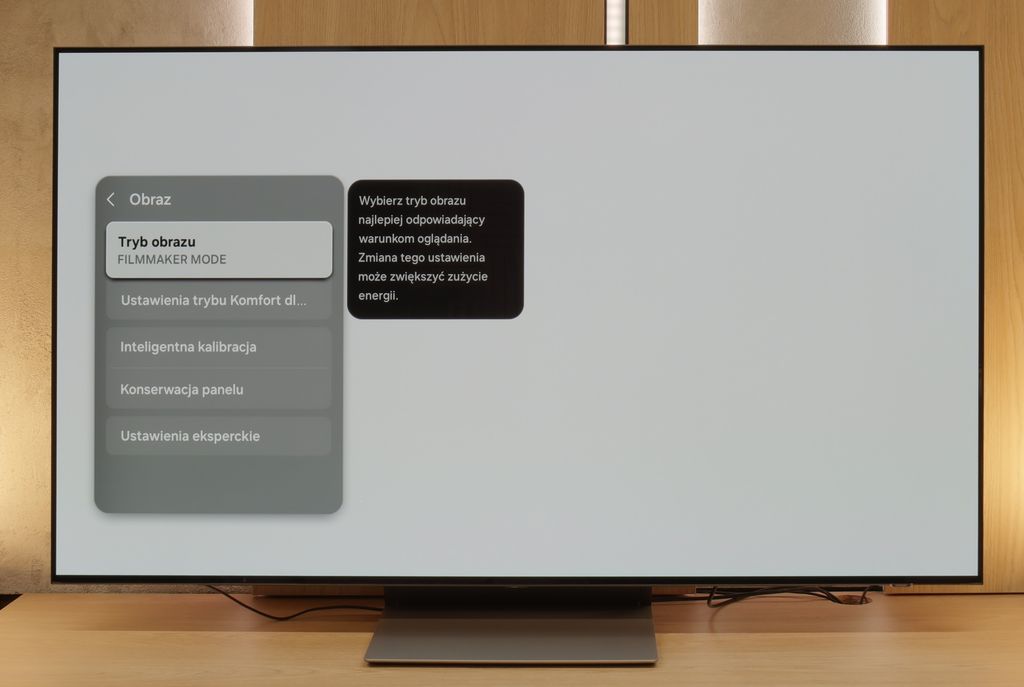
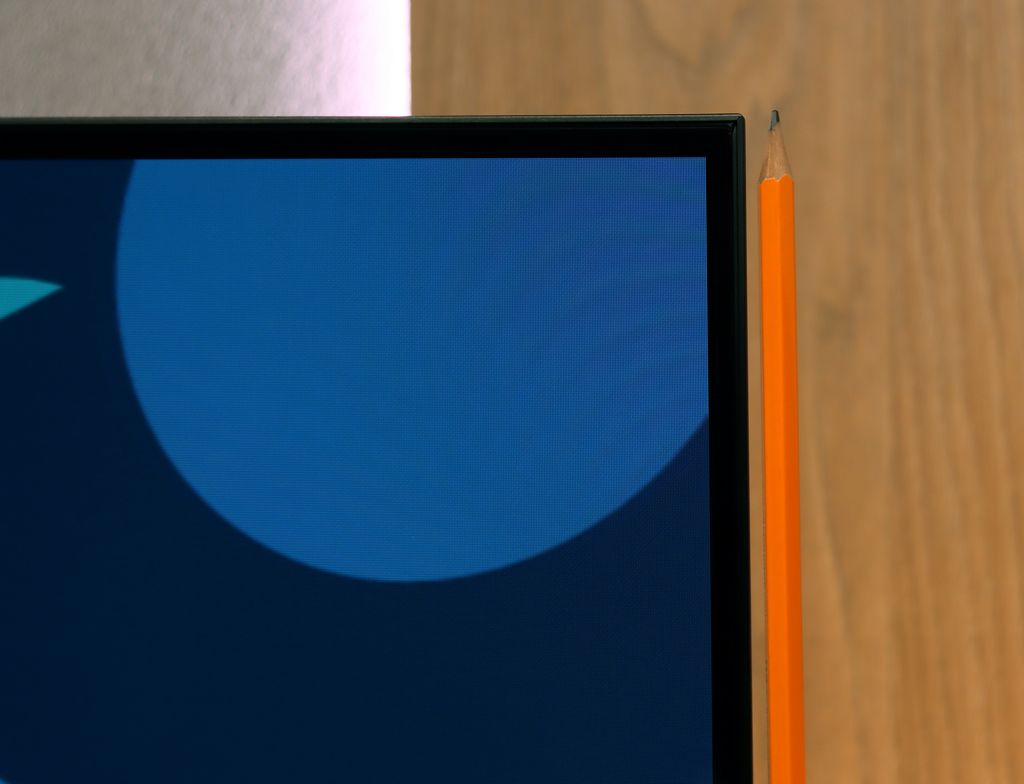
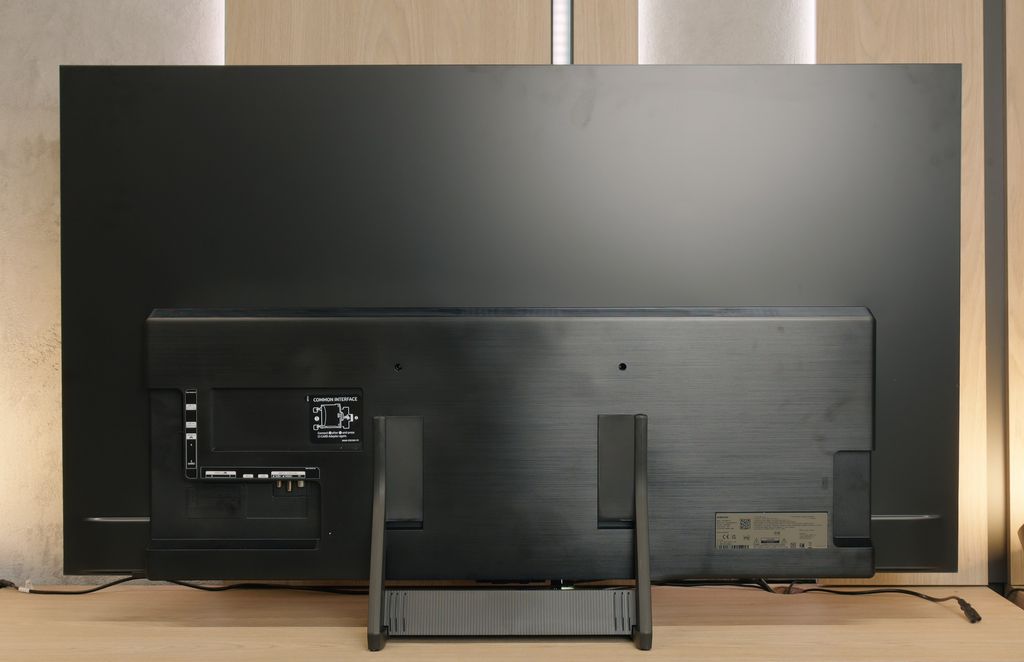
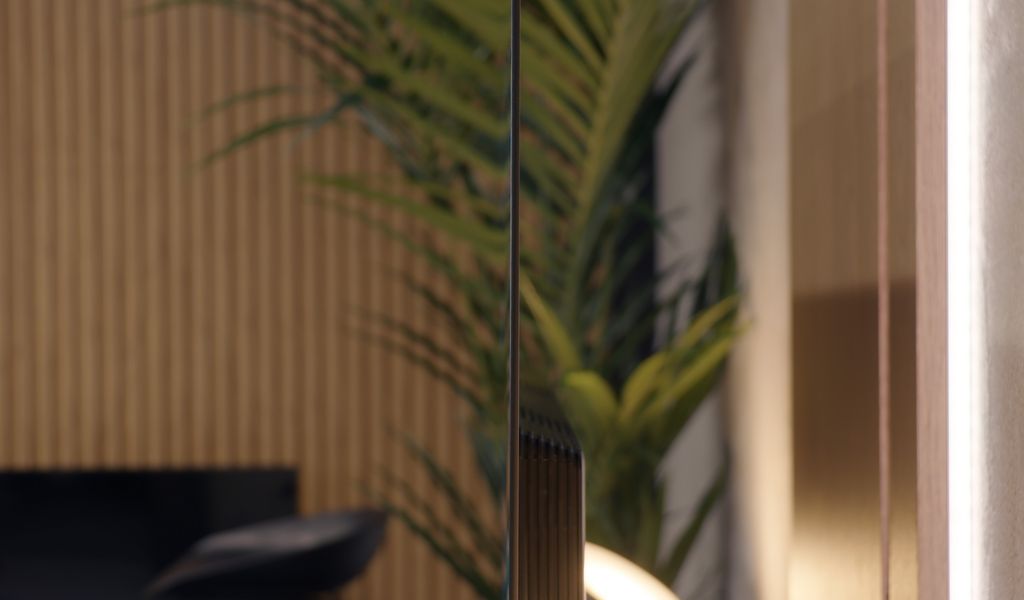
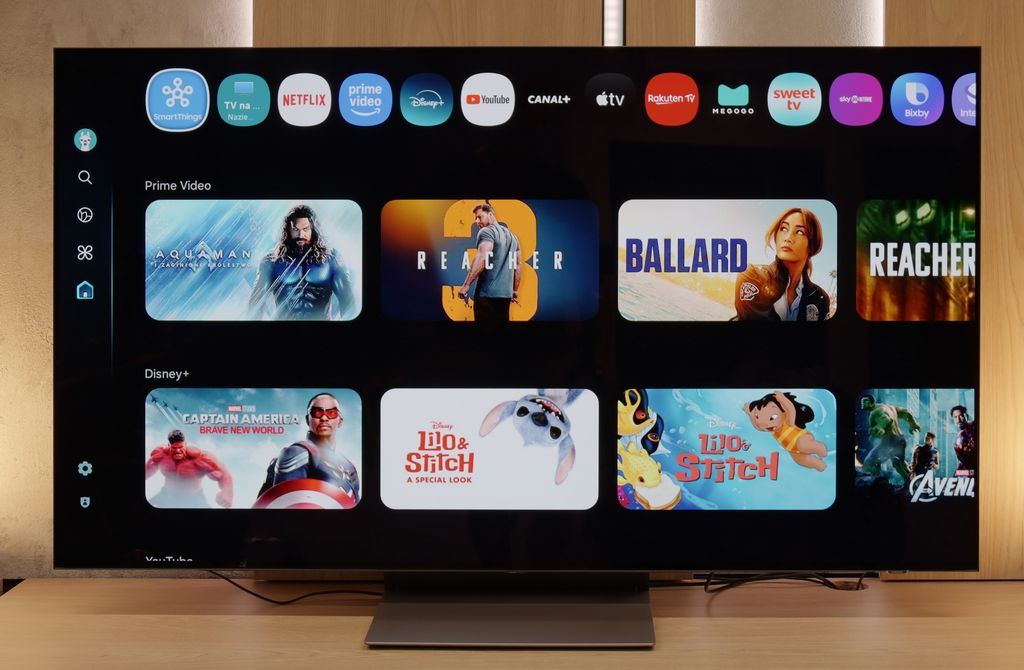
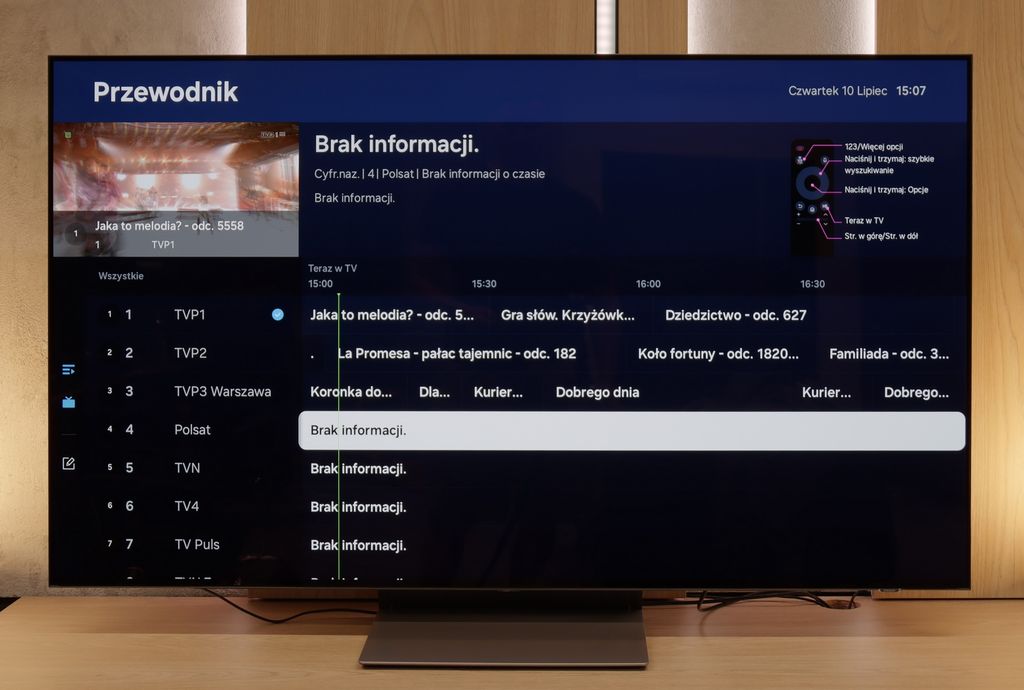
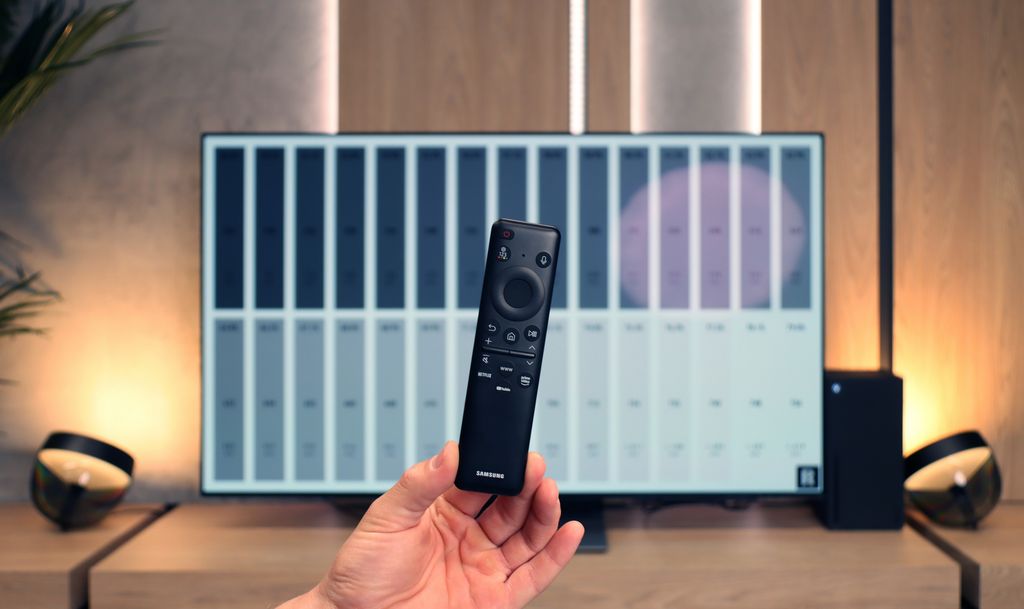
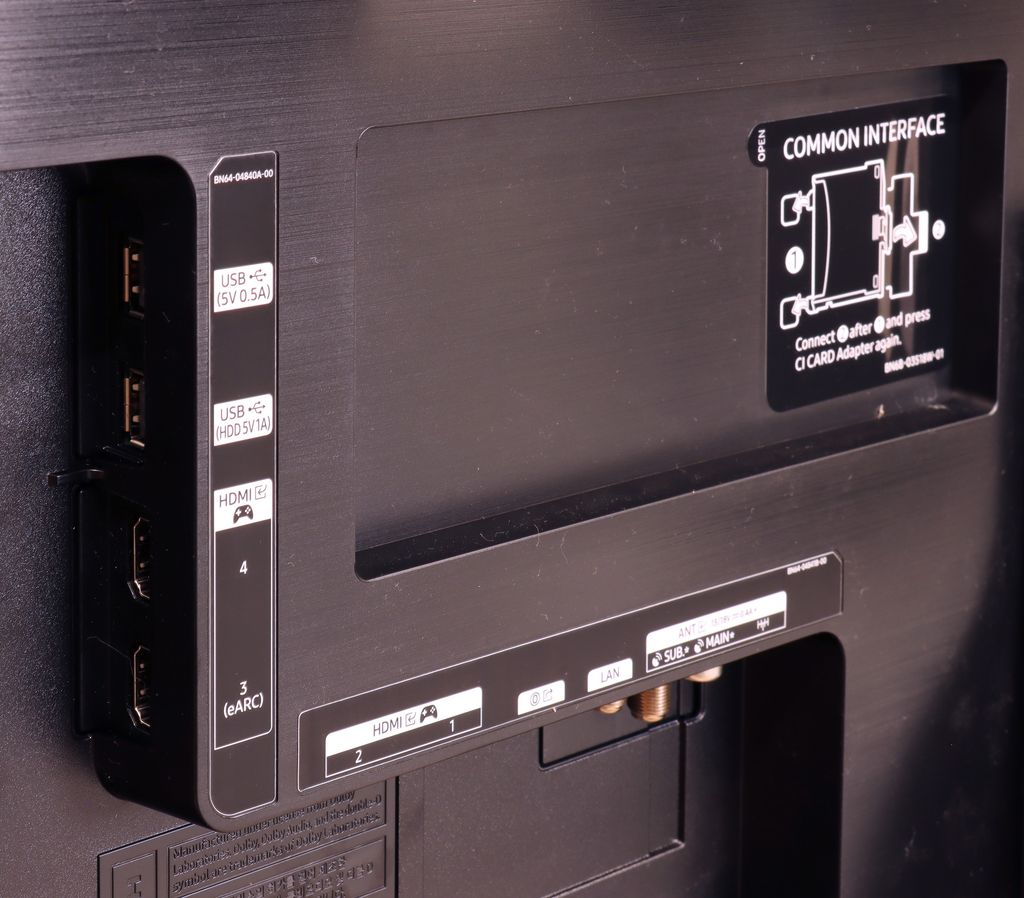
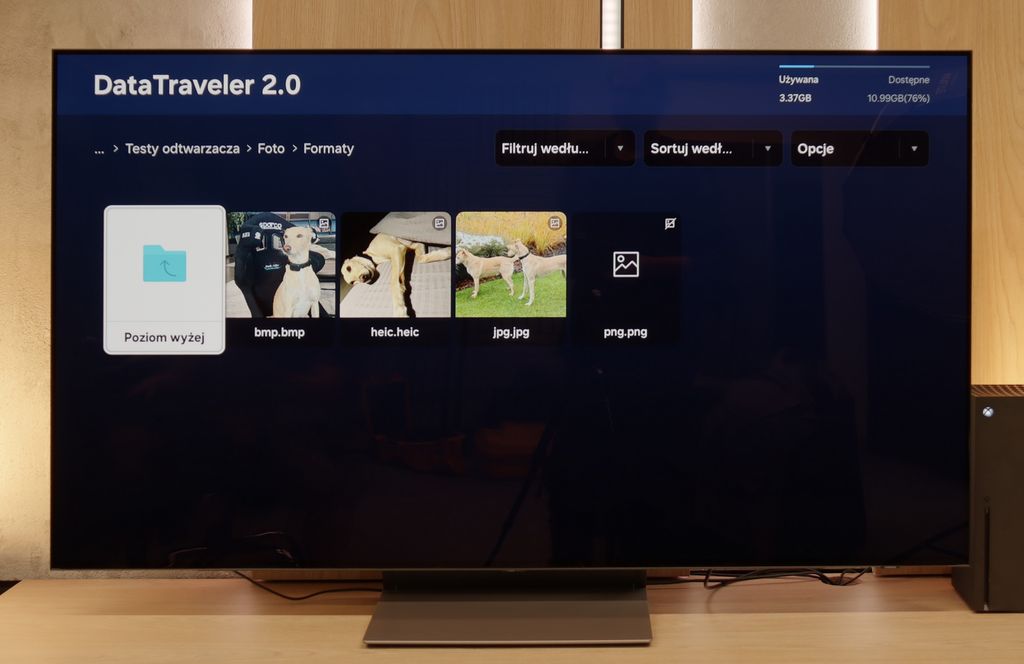
- Regulacja podstawy: stand-Fixed
- Montaż na płasko: Nie
- Akcesoria: accessories-Stand
At first glance, the Samsung S90F is not surprising – and that's not a criticism at all. The styling has hardly changed compared to its predecessor, but it's hard to blame it since we're dealing with a successful, minimalist design of premium class. The television looks very modern – the almost invisible metal bezels surrounding the screen create the impression of a picture panel suspended in the air. The sleek profile of the device is already a classic of the OLED genre – as thin as a smartphone (or even thinner), except for the characteristic "bulge" at the back, which houses the electronics and ports. This means you can't flush the television perfectly against the wall, but in everyday use, it's hard to consider this a disadvantage. Besides, with such a minimalist look, even that detail doesn't spoil the overall impression. The package includes a central metal stand that complements the whole design well. Its biggest advantage is that it allows you to freely place a soundbar in front of the television without blocking the lower part of the screen. It’s worth adding that – like most Samsung televisions from 2025 – the S90F model is equipped with various screen dimming mechanisms, including Ambient Mode. This allows it to display graphics or photos that imitate the appearance of a wall, enabling the television to blend in with the surroundings, especially when wall-mounted.
Buy in the best price
Select size:
SAMSUNG OLED S90F - Contrast and black detail
10/10

Result
∞:1

Result
∞:1

Result
∞:1

Result
∞:1

Result
∞:1
Visibility of details in the lights:
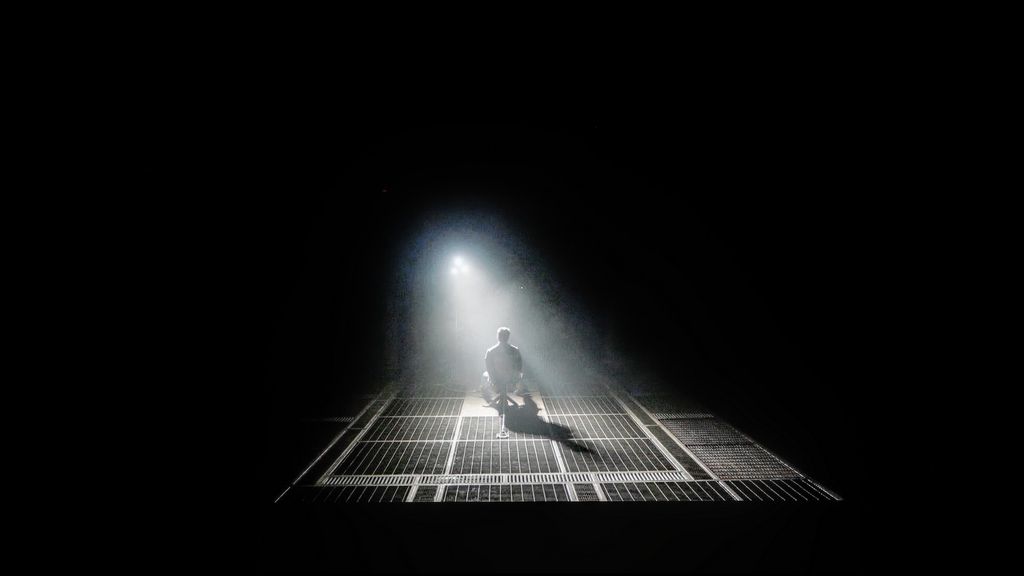
In the case of the Samsung S90F, we have an interesting situation: almost all size variants are equipped with WOLED panels, except for the 65-inch version, which received a QD-OLED panel. In this test, we analyze the version with the WOLED panel produced by LG Display, but the question is: does this affect the quality of black and contrast in this part of the test? In practice – it does not. Regardless of the technology used, both panels can generate perfect black and infinite contrast. This is exactly what we expect from any high-end television. Watching a series in the evening, in a completely dark room, is pure pleasure. The TV easily separates bright elements – like reflections or background lights – from deep, dark parts of the image, creating no halos or brightening, which still plague the highest-class LCD televisions. This is where OLED technology shows its strength – and the S90F is no exception. In terms of black and contrast, we can find absolutely nothing to criticize.
Halo effect and black detail visibility:
SAMSUNG OLED S90F - HDR effect quality
7.2/10
Supported formats: HDR10, HDR10+, HLG Color gamut coverage: DCI P3: 95.2%, Bt.2020: 70.1%
Luminance measurements in HDR:

Result
1099 nit

Result
1177 nit

Result
1252 nit

Result
1183 nit

Result
577 nit
Does the S90F handle not only dark scenes but also bright parts of the image? Definitely yes. Stories about OLEDs as "dark screens" can slowly be regarded as a myth. The Samsung S90F, similar to the LG C5 based on a very similar panel, achieves brightness exceeding 1000 nits. This is a value entirely sufficient to enjoy impressive and dynamic HDR images – both in movies and series. Most of the scenes we tested look stunning, with well-defined lights and high contrast. Of course, OLED technology still has its limitations – with very bright, full-screen sequences, such as the test card from the movie The Meg (5th image), the TV can noticeably dim the image. However, it's worth noting that such scenes are quite rare. One can say that the HDR effect is good enough that even mid-range OLED models, like the S90F, can provide a cinematic experience in the home living room.
Scene from the movie “Pan” (about 2800 nits)

Scene from the movie “Billy Lynn” (about 1100 nits)

The next part of the test only confirms what we've written above. In the case of demanding material, such as Billy Lynn, the television has absolutely no problems rendering the scene in almost reference-level brightness. The fireworks in the background, the amount of detail, the tonal range – everything is in its place, exactly as the director would likely wish. Of course, we didn’t stop at the easy sequences and also checked how the S90F handles more challenging content, such as the film Pan. Such scenes – very bright, dynamic, and at the same time full of contrast – still belong to the rarities, but they are appearing more frequently, so it’s worth knowing if the television is ready for them.
And here’s another positive surprise. The S90F effortlessly rendered the most difficult parts of the scene – sunlight maintained appropriate intensity without losing detail. The glare effect was distinct; we can only nitpick that at times the brightness of the sun was a bit too boosted against the reference standard, but such an effect will be noticed only by the most demanding enthusiasts with a specific point of reference. Theoretically, the S90F could manage these extremes better thanks to the dynamic tone mapping function; however, as is often the case with Samsung televisions, the "active" option harms the S90F more than it helps, completely brightening the image and washing out contrast. We definitely recommend keeping this feature turned off – even without it, the television handles most HDR material in an outstanding manner.
HDR luminance chart:
Luminancja HDR
Luminance of RGB colors
There are also movies for which the S90F doesn't need to adapt anything on its own or guess what the author intended. This is all thanks to dynamic metadata formats such as Dolby Vision and HDR10+. In the case of Samsung, we are dealing with the latter. Although it is still a less popular standard than Dolby Vision, more and more platforms and manufacturers are starting to support it year by year. And that’s good, because with HDR10+ the TV can extract significantly more from the image – especially in those difficult scenes where a lot is happening, the lighting changes dynamically, and the contrast reaches extremes. The S90F handles such moments really well. Importantly, HDR10+ is no longer an exotic addition; you can find it on Amazon Prime Video, and recently also on Netflix. It’s a format that truly makes a difference, and it’s great that the S90F has it onboard. Although Dolby Vision wouldn't be a "bad" addition either.
Static HDR10

Dynamic: HDR10+

Factory color reproduction
7/10
Samsung S90F, like most modern TVs, offers many picture modes, but – in line with our testing tradition – we checked it in its best one, which is the Filmmaker mode. As a result, the image looks much more natural than in the default, often oversaturated settings. It was neither overly saturated nor artificially subdued – just closer to what you should see. Of course, "more correct" doesn’t mean "perfect." Our S90F sample unfortunately had significant issues with white balance, particularly in the blue color range, resulting in a slightly yellowish filter applied to most scenes. Someone might say that it looks more "cinematic" – because it's warmer – but let's be honest, George Lucas didn't film Star Wars in sepia 😉 (you'll find the comparison with the scene as always below).
Additionally, in HDR materials, there was a noticeable issue with brightness management. The EOTF curve showed a distinct "spike" in brightness – the TV brightened the image more than it should have, making some effects look too intense and diverging from the reference. Thankfully, some of these issues can be eliminated with professional calibration – you can read about its effects later in the review.
Color reproduction after calibration
9.2/10
After calibration, we managed to eliminate almost all the aforementioned errors. Older movies in SDR quality finally look as they should – without the sepia effect or artificial aging of the image. The atmosphere of the classics is returning to its rightful place (you're welcome, Star Wars fans), and the colors no longer resemble an Instagram filter.
One of the key changes was also the improvement of brightness characteristics in HDR content. We managed to control the EOTF curve in an almost reference way. Yes, the most demanding users may notice minimal deviations in brightness, but to be honest – most viewers won't even notice that. And it’s no wonder, because the vast majority of errors are below the ΔE 3 threshold, which is below the visibility threshold. After calibration, the S90F (WOLED) becomes a truly excellent display – one that you can enjoy nearly perfect image quality on.
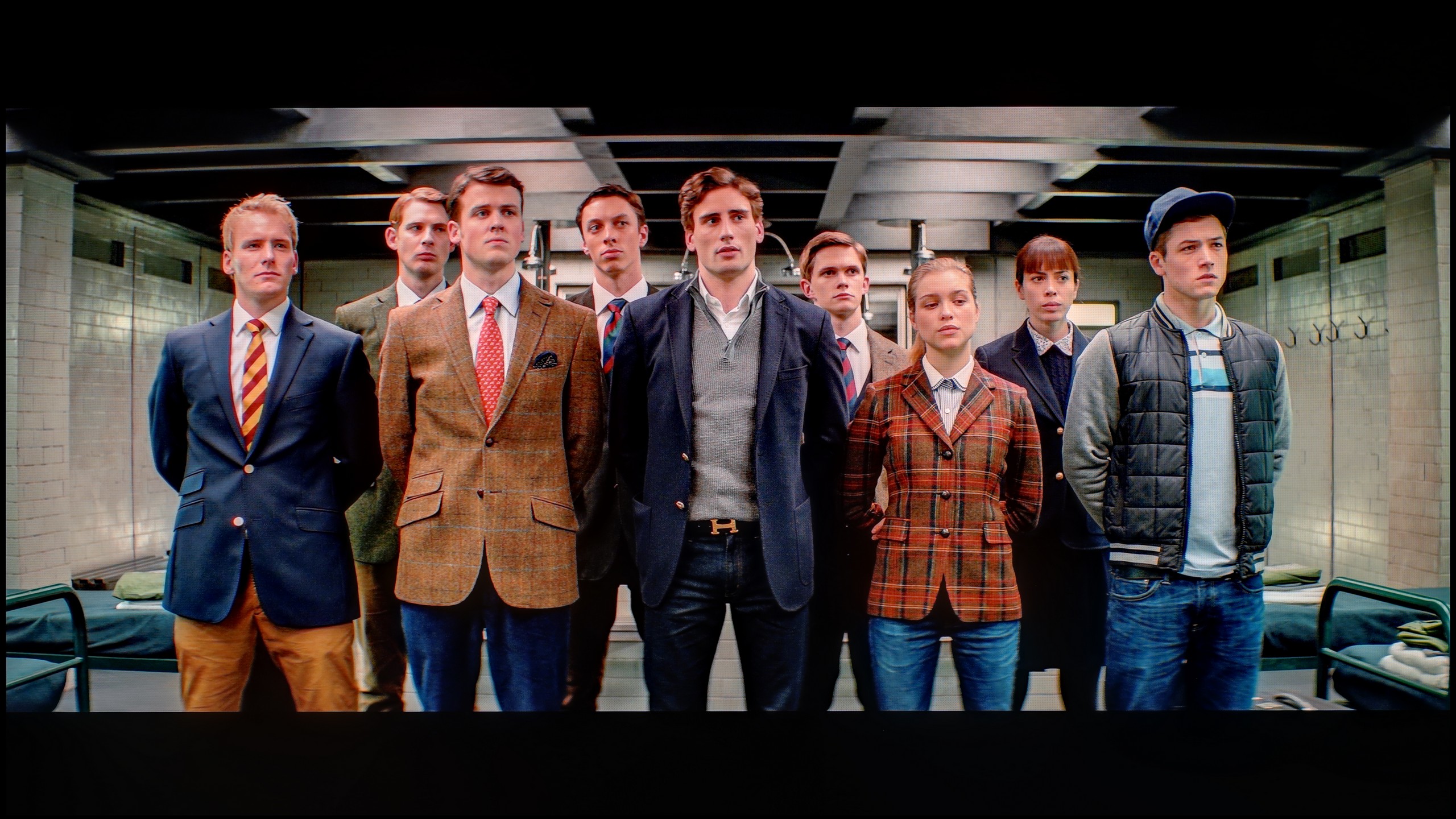

SAMSUNG OLED S90F - Smoothness of tonal transitions
7.3/10
Well, here we have to honestly admit – the S90F has let us down a bit. Compared to last year's S90D model with a WOLED panel (very similar to the one used this year), this year's Samsung has performed worse. And not only in comparison to its main competitor, the LG C5, but even when set against its older brother. The biggest problems arise in dark scenes, where difficulties in smoothly blending colors are visible – the screen slightly struggles with tonal transitions, causing some parts to lose their naturalness. We don't know exactly what went wrong – maybe it's a matter of software or a different processing algorithm. It's a shame because we were hoping that last year's level would be at least maintained. Unfortunately, it’s a step back.



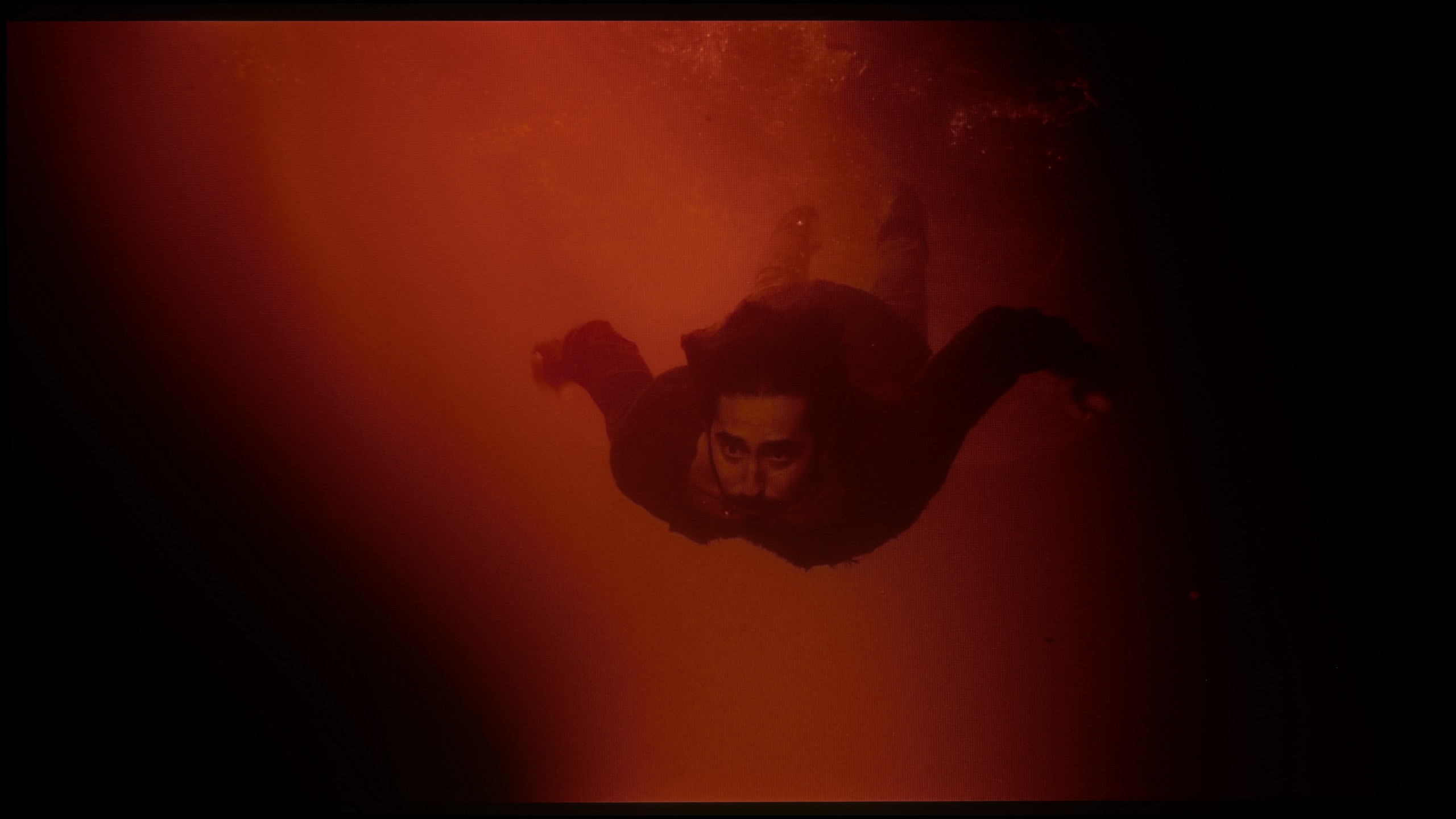




Image scaling and smoothness of tonal transitions
7.5/10
Smooth transition function
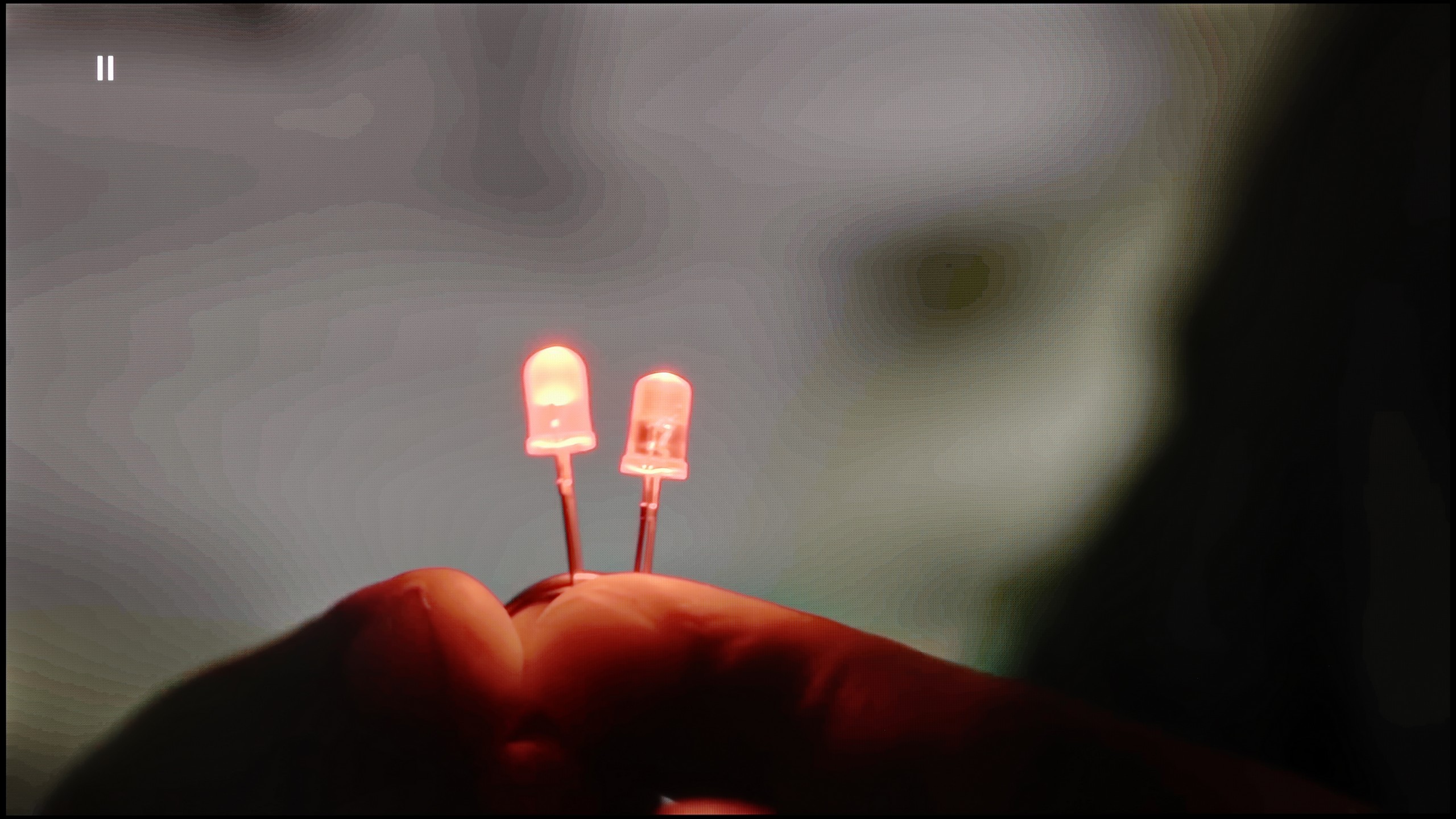
Image without overscan on the SD signal

Digital image processing in the S90F:
Fortunately, Samsung, as in most of its models, can effectively deal with the unwanted posterization effect in the S90F. The function responsible for this element is noise reduction, which quite nicely smooths out tonal transitions and eliminates unnatural color joins – of course, within its capabilities. Unfortunately, it works quite aggressively, so using it comes with compromises. In addition to improving gradation, it may also remove film grain or gently soften facial features. In this case, the choice is yours – do you prefer a more "clean" image, or do you care about preserving the original texture of the material.
Image scaling in the S90F:
In this year's model, Samsung has implemented its own AI processor – NQ4 Gen3, which really manages quite well with upscaling. In our test scenes, the television effectively "pulled up" lower-quality content towards artificial 4K – the image was more pleasant to view, and the differences in sharpness between native and scaled content were minimal. Unfortunately, behind this entire AI marketing façade lies a certain shortcoming. The S90F does not handle overscan well. If you reach for truly archival materials – like a VHS tape of your parents' wedding – you must reckon with the fact that the lower part of the image may be cut off. The image adaptation function to the resolution simply does not work here as it should.
SAMSUNG OLED S90F - Blur and motion smoothness
8.5/10
Maximum refresh rate of the panel: 144Hz
Film motion smoothing option: Yes
Blur reduction option: Yes
BFI function 60Hz: Yes, 60Hz (image flickers)
BFI function 120Hz: No
Brightness drop with BFI: 49%
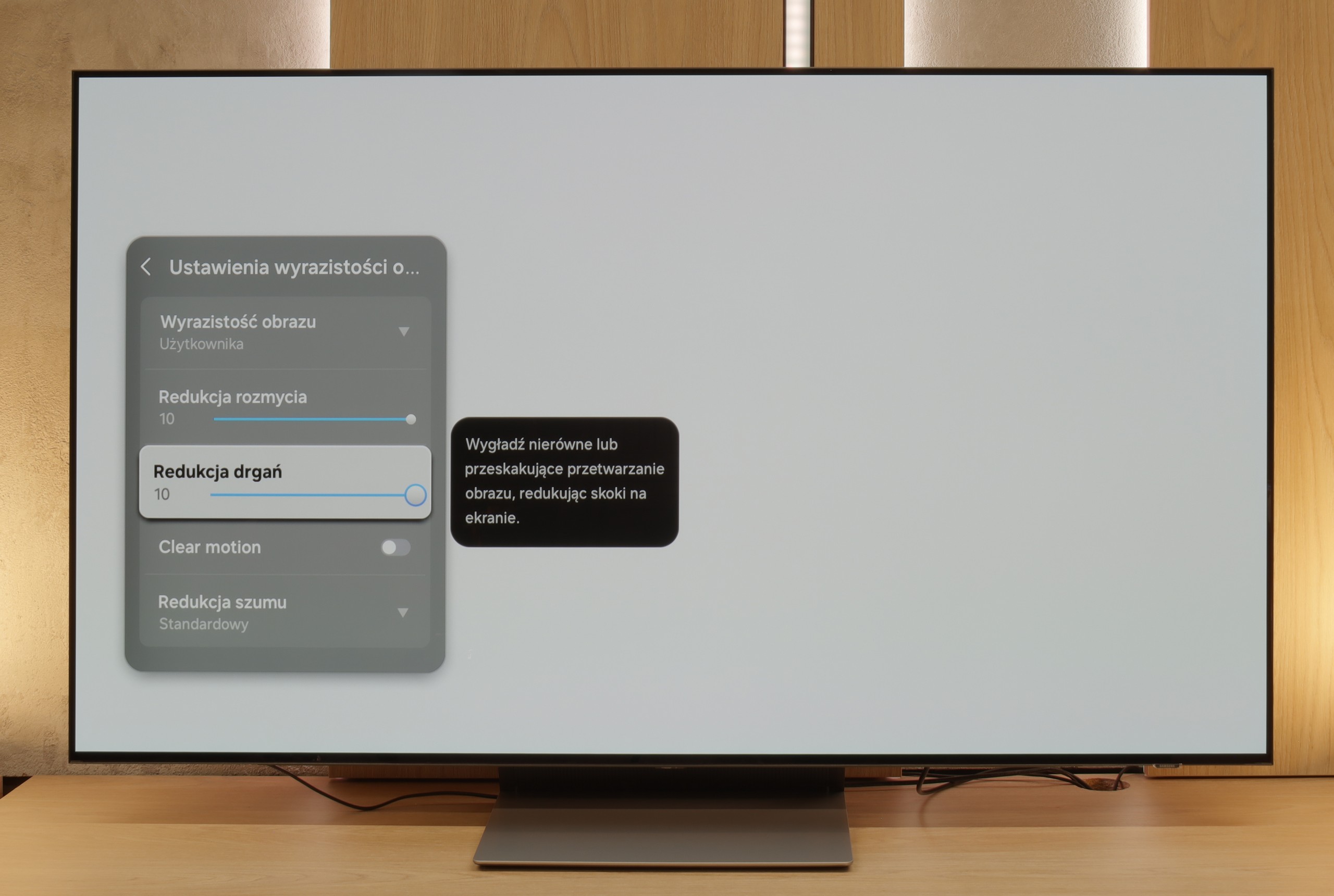
S90F really handles motion great – after all, it's an OLED with a 144 Hz panel, so sports and games look simply amazing on it. The picture is smooth, clear, and there's no room for ghosting or blurring that sometimes plagues cheaper LCDs.
The TV is also equipped with motion smoothing settings that allow you to tailor everything to your liking. We have motion blur reduction and judder reduction – you can set it up to make the picture super smooth (even to that soap opera effect), or more cinematic, with the classic "choppiness" of 24 frames. The choice is yours; Samsung doesn't impose anything.
Blur (native resolution, maximum refresh rate):



When it comes to ghosting – there’s no need to elaborate. It’s OLED, so the response time is instantaneous. In our test with the little green man, the image was sharp, regardless of the background. LCD TVs can only dream of something like that.
SAMSUNG OLED S90F - Console compatibility and gaming features
9.5/10
ALLM: Yes
VRR: Yes
VRR range: 48 - 144Hz
Dolby Vision Game Mode: No
Correct implementation of HGIG: Yes
1080p@120Hz: Yes
1440p@120Hz: Yes
4K@120Hz: Yes
Game bar: Yes
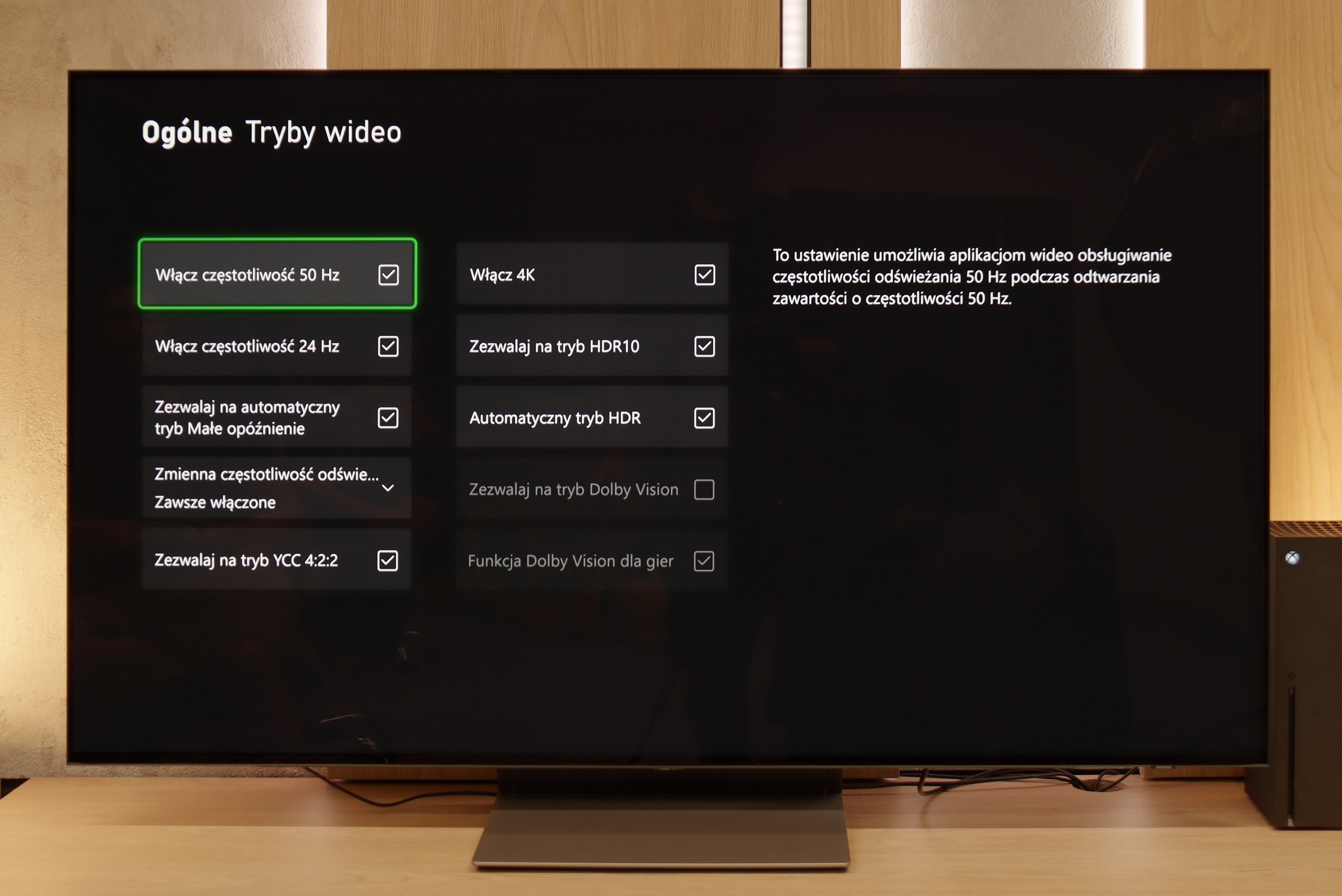
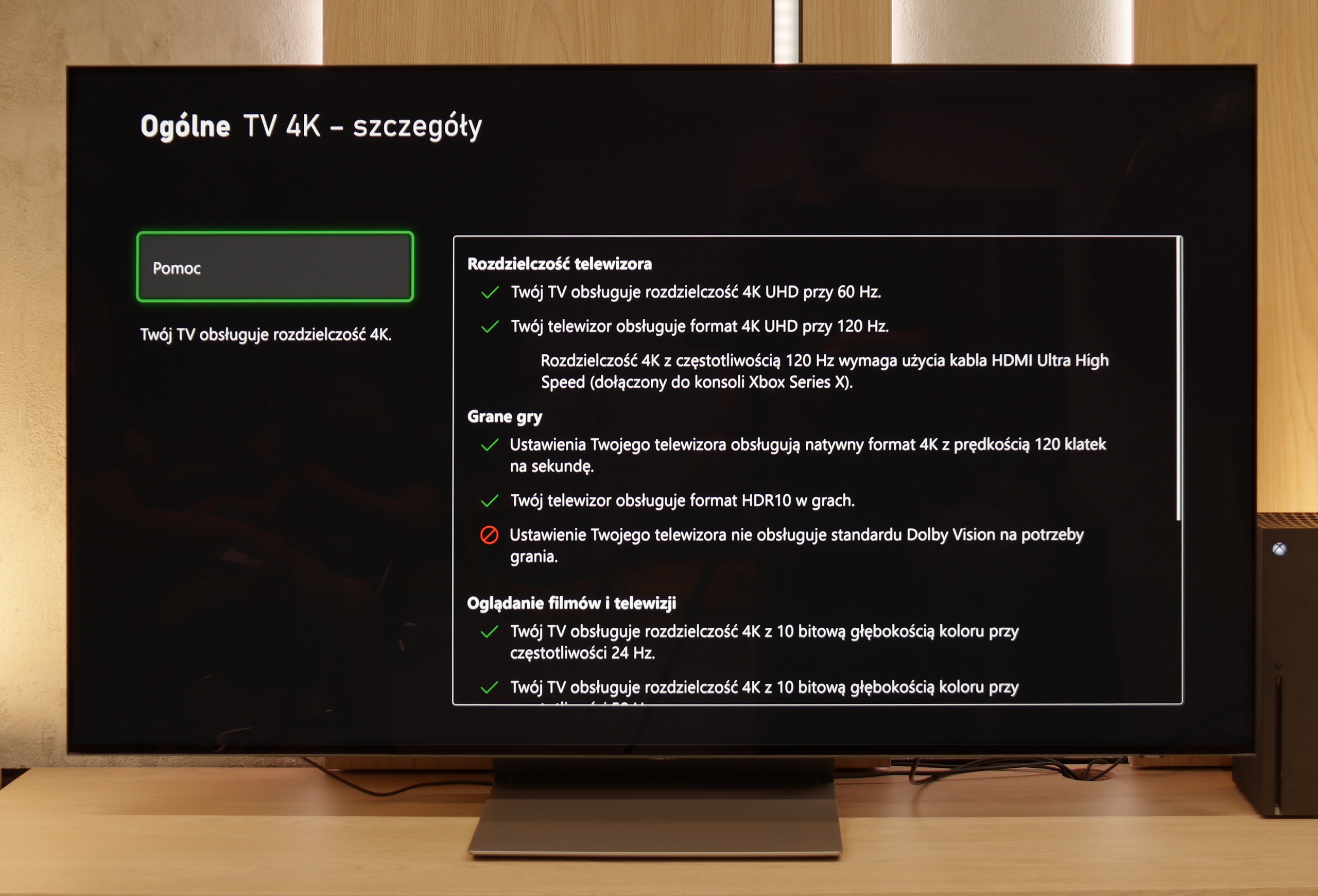
When it comes to gaming features – we have absolutely no complaints about the S90F. Aside from the lack of Dolby Vision, which is already the norm for Samsung. The TV operates at 144 Hz, has four HDMI 2.1 ports, so you can easily connect more than one console or PC. It also includes Game Bar – a practical tool that allows you to quickly preview picture settings, VRR status, ALLM mode, and other useful options. Game Motion Plus is also noteworthy – Samsung’s proprietary motion smoother, which uniquely works well in games. The image feels smoother without any artificial effects or slowdowns.
It’s also worth mentioning the HGiG feature, which – surprisingly – works correctly. We mention this because Samsung clearly broke something in one of its recent updates, and in some models, the option responsible for HGiG simply... disappears from the menu. Setting it becomes virtually impossible. Fortunately, our S90F unit did not have this issue, but the situation is dynamic, so it’s worth keeping this in mind and regularly checking for new software versions and information from the manufacturer.
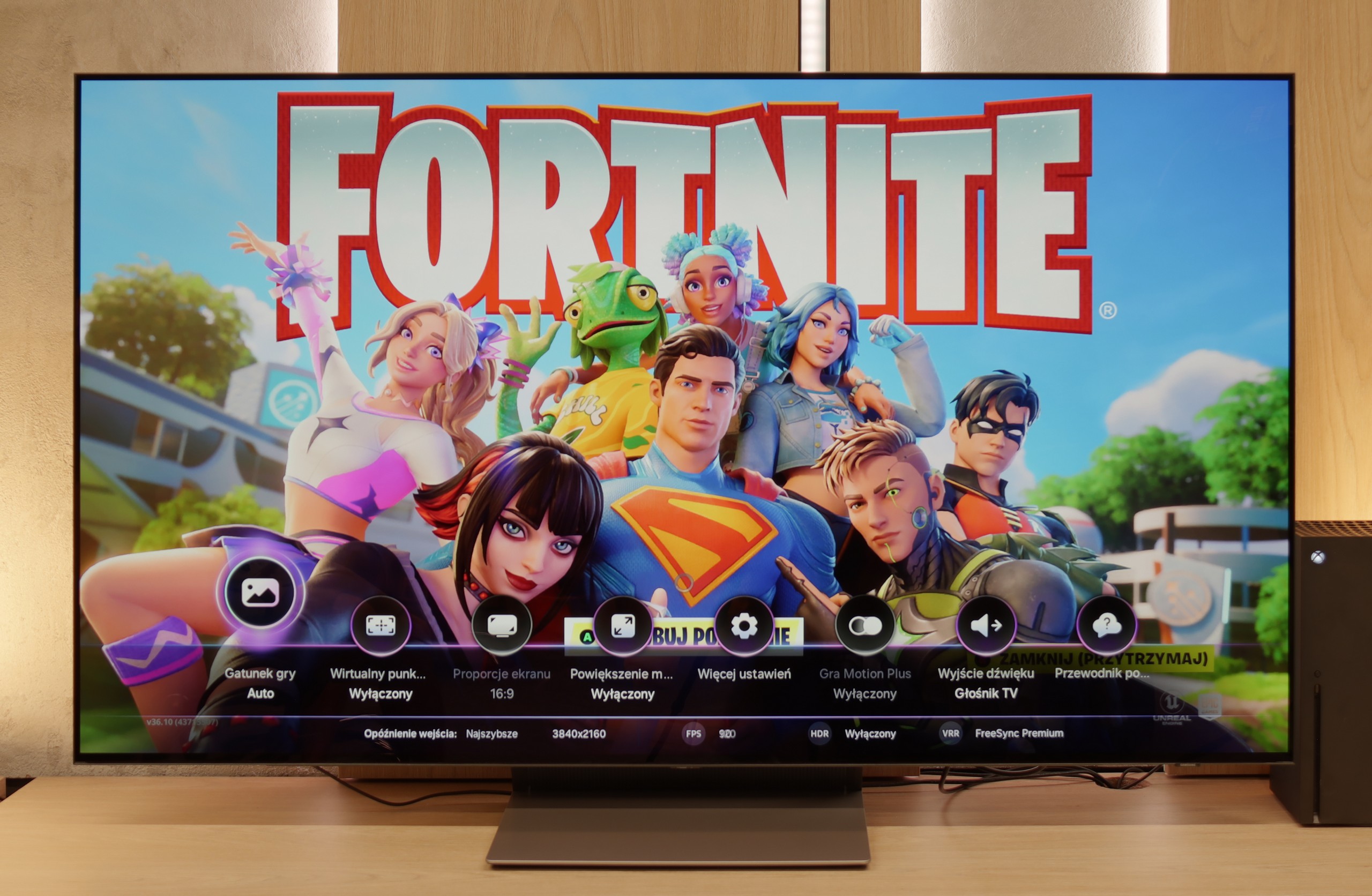
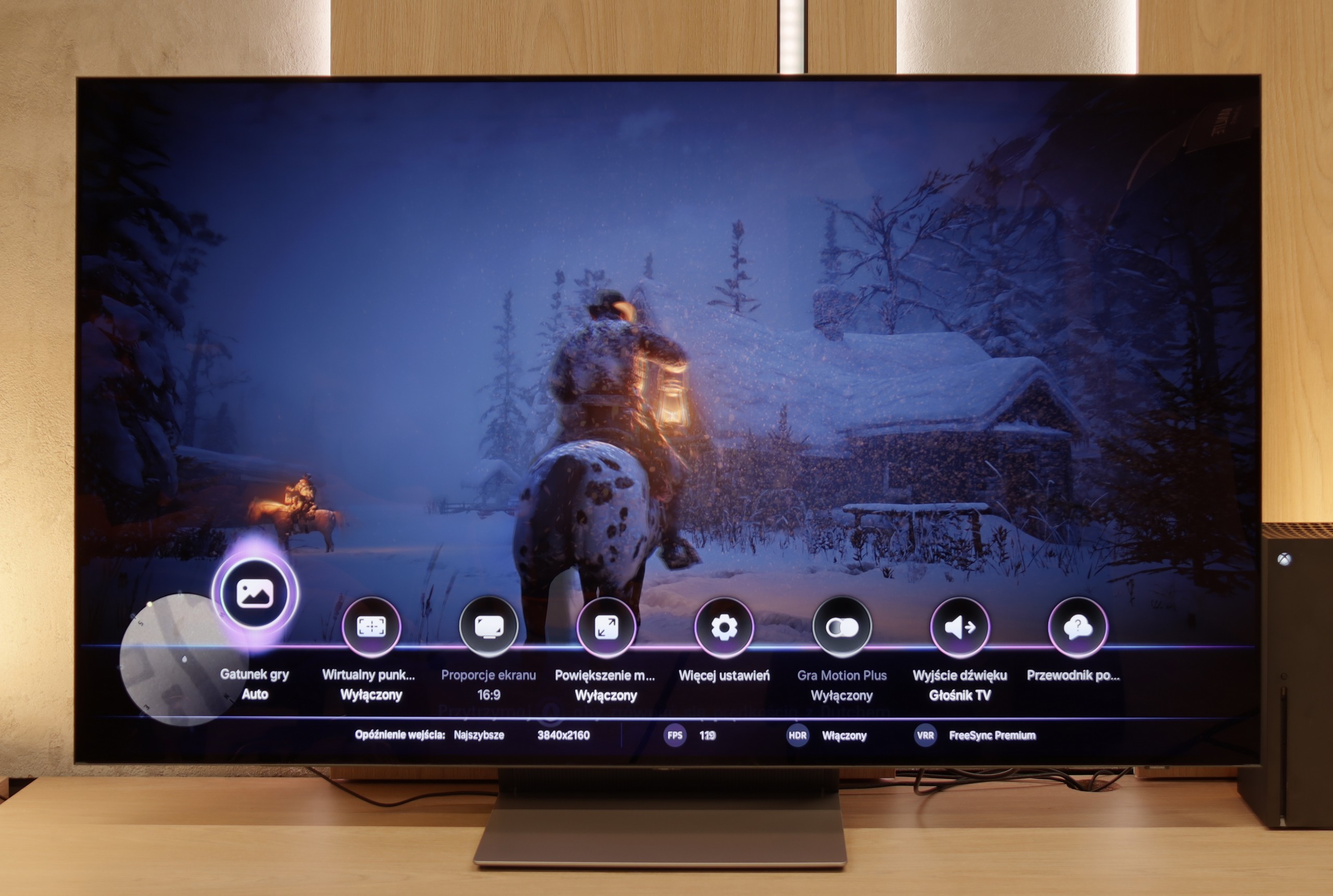

SAMSUNG OLED S90F - Input lag
10/10
The input lag on the S90F is at a truly monitor-level. In the best conditions, a result of 5 ms was achieved, which is absolutely outstanding – even a reference for the most demanding gamers. Whether you are playing fast-paced shooters, fighting games, or simply need instantaneous response – the S90F does not disappoint in this aspect at all.
| SDR | HDR | Dolby Vision |
|---|---|---|
| 1080p60: 11 ms | 2160p60: 10 ms | |
| 1080p120: 6 ms | 2160p120: 5 ms | |
| 2160p60: 11 ms | ||
| 2160p120: 6 ms |

SAMSUNG OLED S90F - Compatibility with PC
8.6/10
Chroma 444 (maximum resolution and refresh rate): Yes
Font clarity: Good
Readability of dark text and shapes: Very Good
Input lag in PC mode (4K, maximum refresh rate): 5ms
Matrix subpixel arrangement: RWBG
Max refresh rate: 144Hz
G-Sync: Yes
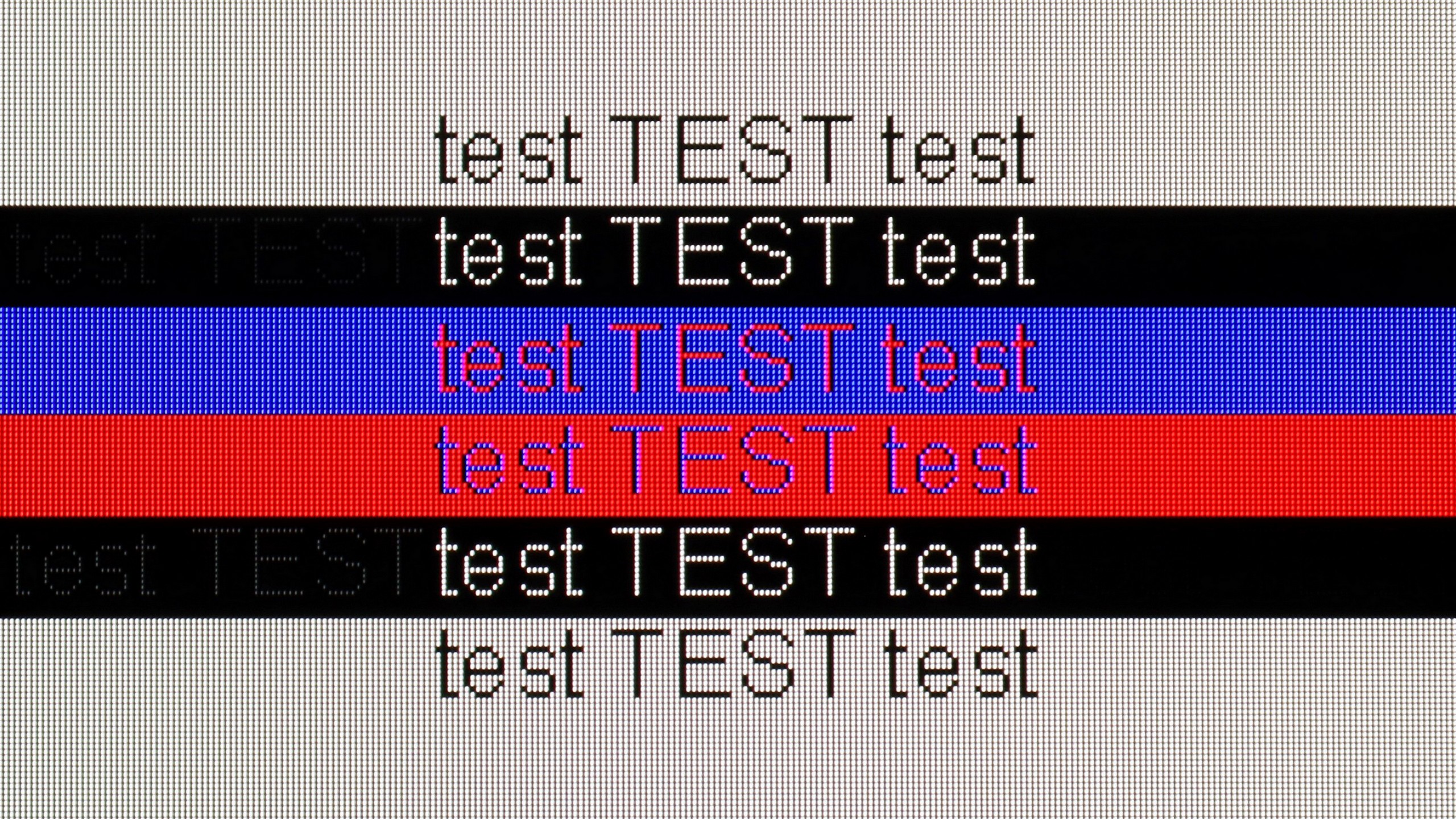
The S90F is a great tool for both PC gaming and everyday work. Gamers can sleep easy – the television easily supports image synchronization with NVIDIA graphics cards thanks to G-Sync, and the 144 Hz refresh rate combined with very low input lag just confirms this. The S90F also works well as a monitor for text work. Of course, the readability of fonts may be slightly affected by the characteristic pixel structure in the RWGB layout, but this is a topic well known mainly to those who work with large amounts of text, code, or spreadsheets in Excel. For most users, this will be completely acceptable.
SAMSUNG OLED S90F - Viewing angles
7.4/10
Brightness drop at an angle of 45 degrees: 31%
The viewing angles on the S90F are very good, although it's fair to admit that they slightly lag behind the 65" version with the QD-OLED panel. Nevertheless, the picture quality at a wide angle is very good – colors remain vivid, and brightness does not drop drastically when viewed from the side. There is no need to shift the TV toward you to see a clear image. For most users, this level is completely sufficient.
SAMSUNG OLED S90F - TV efficiency during daytime
6.1/10
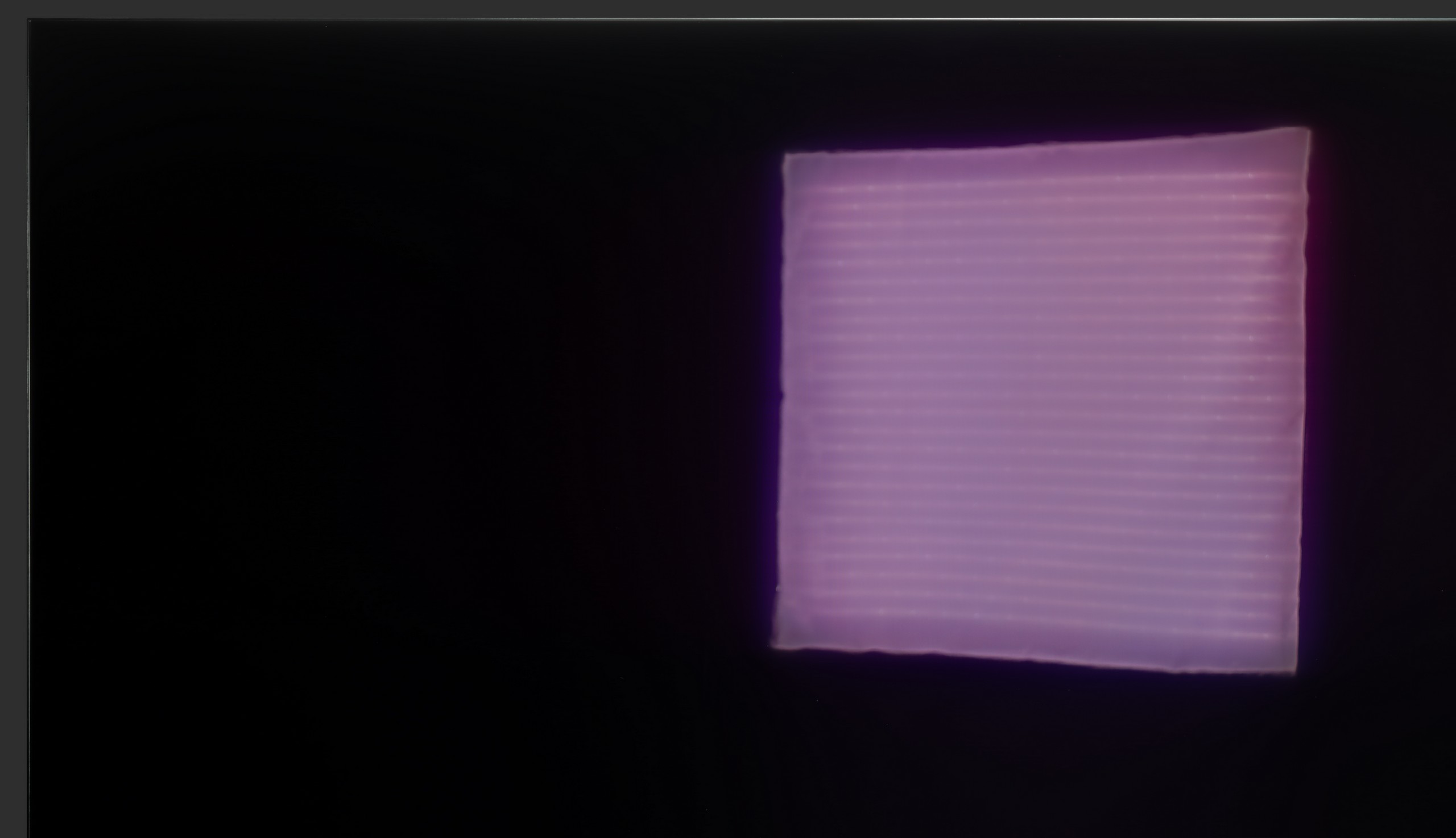

Matrix coating: Glare
Reflection suppression: Decent
Black levels during daytime: Very Good
S90F is really bright for an OLED TV. Of course, it can't be compared to Mini-LED TVs or the brightest high-end OLEDs, but under normal lighting conditions, it's easy to watch something during the day. The brightness is high enough that you don't need to close the curtains every time you watch a movie or a series. However, it's important to remember that the anti-reflective coating on WOLED panels is not the best. Reflections can be visible, especially with bright light coming in from the window. In such cases, it's best to reach for curtains.
Matrix brightness
Average luminance SDR
SAMSUNG S90F (WOLED): 405 cd/m2
SAMSUNG OLED S90F - TV features
7.5/10
System: Tizen
TV reception: DVB-T, DVB-T2, DVB-S, DVB-S2, DVB-C
Recording to USB (terrestrial TV): No
Recording programming: No
Picture in Picture (PiP): Yes
Screen mirroring (Windows Miracast): Yes
AirPlay: Yes
Voice search in native language: Yes
Ability to connect a keyboard and mouse: Yes
Possibility to connect Bluetooth headphones to the TV: Yes
Possibility to simultaneously use Bluetooth headphones and the TV speaker: Yes
Audio only mode: Yes
RF remote control (no need to aim at the screen): RF
Backlit remote control: No
Teletext: Yes








The Samsung S90F is equipped with many classic TV features such as EPG, CI module, and headphone support, but there's also something more here. Thanks to the presence of several tuners, the television offers a picture-in-picture (PiP) function – very useful, for example, when we're watching one match but want to glance at the score of another one happening simultaneously. It's a shame that Samsung has completely abandoned USB recording for some time now, but it somewhat compensates for this with good integration with decoders and other devices. The remote – although small and lacking a numeric keypad – allows control of many devices connected to the television. We can easily operate a decoder, amplifier, console, or other equipment with it, and this can be done without the need to reach for multiple remotes.
As for the Smart TV system – Tizen on the S90F works very smoothly, which is not always the case with cheaper models featuring this system. The system itself is extensive and offers plenty of features – we have screen mirroring, AirPlay, Bluetooth device support, and many options related to smart home control, such as managing light bulbs or other smart devices directly from the television. However, it's important to remember that Tizen is a closed system, so when it comes to apps – we are limited to what we find in the Samsung store. While this store is quite extensive, it does not match the flexibility of the Google TV platform. It's worth keeping this in mind if you have specific needs for niche applications.
SAMSUNG OLED S90F - Apps
8.2/10























SAMSUNG OLED S90F - Playing files from USB
7.5/10

| Maximum photo resolution: | Supported photo formats: |
|---|---|
The built-in media player in the S90F is fine and supports a good number of popular formats. Unfortunately, during testing – once again – we encountered issues despite the manufacturer's claims. The TV did not play some formats that are supposedly supported, such as HEIC photo format (Apple's version) or SRT and SUB text subtitles. In the daily use of most people, such a player is probably sufficient to run a movie from a USB drive, but it's worth keeping in mind that surprises can happen. Perhaps the situation will improve in future updates, but at the time of writing this review – it works as it works.
SAMSUNG OLED S90F - Sound
7.4/10
7.4/10
Subjective sound quality
Supported codecs
(TV speakers)
Dolby Digital Plus 7.1
Dolby True HD 7.1
Dolby Atmos in Dolby Digital Plus (JOC)
Dolby Atmos in Dolby True HD
DTS:X in DTS-HD MA
DTS-HD Master Audio
Supported codecs
(external HDMI eARC audio)
Dolby Digital Plus 7.1
Dolby True HD 7.1
Dolby Atmos in Dolby Digital Plus (JOC)
Dolby Atmos in Dolby True HD
DTS:X in DTS-HD MA
DTS-HD Master Audio
The S90F sounds really pleasant, with noticeable bass and quite good dynamics. A definite plus is the support for Dolby Atmos, which allows the television to sound a bit more "spatially" – of course, as much as the built-in 2.1 system allows 😉. Unfortunately, as with Samsung, there is no support for the DTS:X format. So if you want to take advantage of its capabilities, you need to connect the audio equipment directly to the receiver, not to the television itself – otherwise, it simply won’t work.
SAMSUNG OLED S90F - Details about the matrix
Software version during testing: T-RSMFDEUC-0090-103 2.5, E2500007, BT-S
Panel uniformity:


Founder and originator of the "ChooseTV" portal

Journalist, reviewer, and columnist for the "ChooseTV" portal
See articles related to SAMSUNG S90F (WOLED):
6/13/2025













